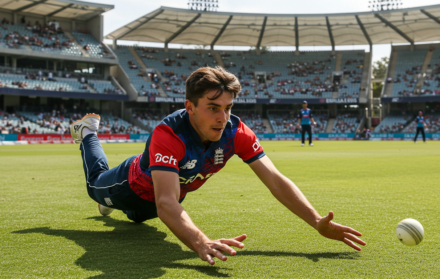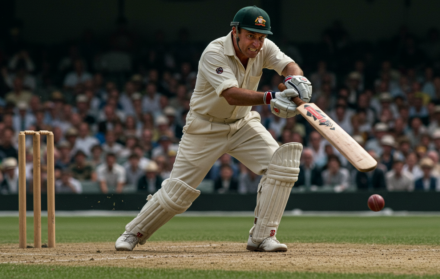
How To Bowl Effectively In The Death Overs Of A Cricket Match
Bowling effectively in the death overs of a cricket match requires a unique set of skills, tactics, and strategies. The death overs, typically the final four to five overs of an inning, are crucial for both the bowling and batting team.
To succeed as a bowler in this high-pressure situation and restrict the opposition’s scoring, certain essential skills must be mastered. Furthermore, employing effective tactics and strategies can make a significant difference in the outcome of the match.
Lastly, continuous practice is essential to improve bowling skills and gain confidence in executing various deliveries. Understanding the death overs, developing essential skills, implementing effective tactics, and regular practice are key elements to bowl effectively in the death overs of a cricket match.
In this article, we will delve into these aspects and provide valuable insights and tips to help you excel in this critical phase of the game.
Understanding the Death Overs in Cricket

Understanding the death overs in cricket is crucial for both the bowlers and the fielding team. The death overs refer to the final few overs of an inning, typically between the 16th and the 20th over in a T20 match.
This phase of the game is where the batting team strives to maximize their score, while the bowling team aims to restrict them. It requires strategic planning, accurate execution, and the ability to handle pressure. Bowlers must possess the skills to bowl yorkers, slower balls, and change of pace deliveries in order to deceive the batsmen.
Essential Skills for Bowling in the Death Overs
Bowling in the death overs of a cricket match requires a unique set of skills. In this section, we’ll uncover the essential skills that can make a bowler truly effective in those high-pressure moments.
From consistent yorkers to variations in pace, and from effective use of slower balls to intelligent field placement, we’ll explore the strategies and techniques that can turn the tide in favor of the bowling side. So gear up, because we’re about to dive into the art of mastering the death overs!
1. Consistent Yorkers
Consistent Yorkers are a crucial skill for bowlers in the death overs of a cricket match. These deliveries are aimed at the batsman’s toes, making it difficult to score runs or play big shots. Here are some key points to consider when bowling consistent Yorkers:
- Accuracy and Control: Practice bowling consistent yorkers consistently to improve accuracy and control.
- Variations in Pace: Mix up the pace of your consistent yorkers to surprise the batsman and keep them guessing.
- Length and Line: Aim for the blockhole, just outside or on top of off stump, making it hard for the batsman to get under the ball.
- Reading the Batsman: Analyze the batsman’s footwork and shot selection to anticipate their movements and adjust your line and length accordingly.
- Field Placement: Set a field that supports your consistent yorkers, with fielders positioned to protect boundaries.
2. Variations in Pace
- Change of pace: Incorporate variations in pace by varying the speed of your deliveries to keep the batsman off balance.
- Slow ball: To disrupt the timing of the batsman, introduce a slower ball.
- Fast ball: Surprise the batsman by mixing in a well-executed fast delivery.
- Off-pace delivery: Deceive the batsman by using a slower ball with an off-cutter or knuckleball grip.
- Mixing up lengths: Prevent the batsman from settling into a rhythm by alternating between full-length and shorter deliveries.
Pro-tip: To master the art of keeping the batsman guessing and increase your effectiveness in the death overs, practice variations in pace regularly.
3. Effective Use of Slower Balls
When bowling in the death overs of a cricket match, utilizing slower balls effectively can make a significant impact and change the outcome of the game. Here are some crucial pointers to master the skill of effectively implementing slower balls:
- Become proficient in disguising the slower ball to outfox the batsman.
- Keep the batsman on their toes by varying the pace of your slower deliveries.
- Bowl slower balls with precision and accuracy to induce mistimed shots.
- Strategically aim for the top of the off stump or just outside off to restrict the batsman from scoring easy runs.
- Dedicate practice sessions to developing different variations of slower balls, such as back of the hand slower balls or cutters.
- Observe the batsman intensely to identify their weaknesses and choose the opportune moment to unleash the slower ball.
- Analyze the pitch conditions meticulously and adjust the length and speed of your slower balls accordingly.
By implementing these strategies and diligently honing your skills, you can transform into a formidable death bowler in the game of cricket.
4. Intelligent Field Placement
Intelligent field placement is paramount for bowling effectively in the death overs of a cricket match. Below are some crucial factors to consider when setting up the field during this critical phase of the game:
- Strategically positioning fielders to limit the batsman’s scoring areas, focusing on targeting gaps and areas of vulnerability.
- Ensuring fielders are in the appropriate positions to cut off boundaries and take catches, maximizing the opportunities for wickets.
- Employing a combination of close-in fielders, boundary riders, and sweepers based on the situation and the batsman’s playing style.
- Placing fielders in key positions such as deep square leg, long on, backward point, extra cover, and fine leg to cover common hitting areas.
- Adjusting the field based on the individual bowler’s strengths and the batsman’s tendencies, adapting the positions to exploit weaknesses.
- Effectively communicating and coordinating with the captain, bowlers, and other fielders to ensure clear understanding of roles and responsibilities.
Tactics and Strategies for Bowling Effectively in the Death Overs

When it comes to bowling in the death overs of a cricket match, tactics and strategies play a crucial role in determining the outcome. In this section, we’ll dive into the key elements for effectively bowling during this intense phase of the game.
From preparing yourself mentally to analyzing the batsman’s weaknesses, we’ll explore the strategies that will help you excel. We’ll discuss the importance of setting a defensive field, planning your delivery sequence, executing yorkers with precision, mixing up your deliveries, and evaluating the pitch conditions.
Get ready to enhance your bowling skills and dominate the death overs!
1. Preparing Mentally
Preparing mentally is crucial for bowling effectively in the death overs of a cricket match. Here are some steps to help you prepare mentally:
- Stay calm and focused: Clear your mind and maintain a positive mindset.
- Analyze the situation: Assess the match scenario, the batsman’s form, and the conditions.
- Visualize success: Imagine yourself executing the perfect deliveries and getting wickets.
- Develop a game plan: Strategize your bowling approach based on the batsman’s weaknesses and the pitch conditions.
- Build confidence: Remind yourself of your skills and previous successful performances.
2. Setting a Defensive Field at the Start
Setting a defensive field at the start of the death overs is crucial for a bowler to restrict the batsman’s scoring areas and build pressure. Here are some steps to follow:
- Place fielders in positions that cover gaps and protect boundaries.
- Position deep fielders on the boundary to prevent easy boundaries.
- Keep fine leg and third man inside the circle to save runs.
- Have an extra fielder on the leg side to counter aggressive shots.
- Put a cover sweeper for any mishits towards the off side.
- Keep mid-on and mid-off up to prevent easy singles.
Pro-tip: Adjust the field based on the batsman’s strengths and weaknesses, constantly analyzing their shot selection, and make on-field changes accordingly.
3. Plan Your Delivery Sequence
Planning your delivery sequence is crucial for bowling effectively in the death overs of a cricket match. Here are some key steps to consider to plan your delivery sequence:
- Analyze the batsman’s weaknesses and scoring areas.
- Evaluate the pitch conditions, taking into account factors like bounce and pace.
- Set a good field, strategically placing fielders in areas where the batsman is likely to target.
- Prepare mentally and stay focused on executing your plans.
- Begin with a defensive approach, bowling a good length ball on the off stump to restrict scoring opportunities.
- Mix up your deliveries, including yorkers, slower balls, and variations in pace, to keep the batsman guessing.
- Execute yorkers with precision, aiming for the base of the stumps or the batsman’s toes.
- Observe the batsman’s footwork and shot selection to identify opportunities for mistimed shots.
- Adapt your plan based on the situation and the batsman’s response.
4. Executing Yorkers with Precision
To execute Yorkers with precision in cricket’s death overs, follow these steps:
- Master the art of executing Yorkers: Practice the delivery stride and release to maintain accuracy and control.
- Aim for the batsman’s base: Target the top of the off stump to increase the chances of getting a wicket.
- Focus on the perfect length: Bowl Yorkers that pitch right at the batsman’s toes or slightly fuller to restrict scoring opportunities.
- Develop variations: Incorporate the back of the hand slower ball or other unorthodox methods to surprise the batsman.
- Set up a well-structured field: Position fielders strategically to cover areas where the batsman is likely to score.
- Analyze the batsman’s strengths and weaknesses: Study their weaknesses and adapt your strategy accordingly.
- Practice in match-like scenarios: Simulate pressure situations to improve decision-making and execution of Yorkers with precision.
- Confidence in your skills is crucial: Believe in your abilities and back them up with hard work and practice.
5. Mixing Up the Deliveries

Mixing up the deliveries is a crucial skill for bowlers in the death overs of a cricket match. By varying the type and length of their deliveries, bowlers can keep the batsmen guessing and make it difficult for them to score runs. This includes incorporating the following techniques:
- 1. Yorkers: Delivering accurate yorkers at the batsman’s feet is an effective way to restrict scoring opportunities.
- 2. Slower balls: Changing the pace of the delivery with slower balls can disrupt the batsman’s timing and force them into making mistimed shots.
- 3. Length variations: Mixing up shorter and fuller deliveries can make it challenging for the batsman to predict the length of the ball.
- 4. Change of line: Bowlers can surprise batsmen by bowling wider deliveries outside their comfort zone or targeting different areas of the stumps.
- 5. Variations in spin: Spin bowlers can use a combination of different grips and spins to deceive the batsmen.
In the 1987 World Cup, the Australian bowler Craig McDermott showcased his mastery of mixing up deliveries in the death overs. His ability to bowl yorkers, slower balls, and variations in pace played a significant role in Australia’s victory in the tournament.
6. Analyzing the Batsman’s Weaknesses
- Analyzing the Batsman’s Weaknesses is crucial for a death bowler in cricket.
- Study the batsman’s technique, footwork, and shot selection to identify patterns and weaknesses.
- Observe how the batsman plays against different types of deliveries and adapt your bowling strategy accordingly.
- Target the batsman’s weaknesses by bowling deliveries that exploit his vulnerabilities.
- Use variations in pace, line, and length to keep the batsman guessing and create opportunities for wickets.
- Observe the batsman’s reaction to different types of deliveries in previous matches and devise plans accordingly.
- Stay updated with the batsman’s recent performances and adapt your tactics accordingly.
7. Evaluating the Pitch Conditions
- Evaluating the pitch conditions is crucial for bowling effectively in the death overs of a cricket match. Here are the steps to consider:
- Assess the nature of the pitch – Is it flat, bouncy, or slow?
- Observe the behavior of the ball – Does it swing or seam?
- Analyze the bounce – Is it consistent or variable?
- Consider the weather conditions – Is there any moisture or wind that could affect the ball?
- Study the previous innings – How has the pitch played so far?
- Consult with teammates and captain – Get their insights on the conditions.
- Make necessary adjustments to your bowling strategy based on the evaluation.
In the 2011 ICC World Cup, the pitch conditions in Mohali, India played a vital role in the semifinal match between India and Pakistan. Evaluating the pitch, Indian bowlers adjusted their lengths and variations effectively, restricting Pakistan’s scoring and securing a win.
Practicing and Improving Bowling Skills for the Death Overs

Looking to improve your bowling skills for the death overs in cricket? We’ve got just the section for you! We’ll dive into the essentials of practicing and refining your bowling technique to excel in those crucial final overs.
From working on accuracy and control to perfecting that deadly yorker delivery, and mastering variations in pace and length, we’ve got you covered. Plus, we’ll show you how to simulate match scenarios during practice for an extra edge. Get ready to step up your game!
1. Working on Accuracy and Control
To improve accuracy and control for bowling in the death overs of a cricket match, incorporate the following steps:
- Focus on your delivery stride to ensure a consistent release point and alignment while working on accuracy and control.
- Aim for the top of off stump or just outside the off stump to enhance your line and length, thus improving accuracy and control.
- Hone your stock ball, the one you can rely on for accuracy and to restrict the batsman’s scoring area, thereby enhancing accuracy and control.
- Practice variations in pace by mixing up slower balls with well-disguised pace deliveries to keep the batsman guessing, hence improving accuracy and control.
To excel in the death overs, remember to stay calm, back your skills, and trust your abilities. Keep honing your accuracy and control through regular practice sessions.
2. Perfecting the Yorker Delivery
To perfect the yorker delivery in cricket, follow these steps:
- Master Control and Accuracy: Develop precise control over line and length to consistently hit the blockhole.
- Perfecting the Yorker Delivery: Position yourself wide of the crease to create a sharper angle and make it harder for the batsman to pick the length and line of the delivery.
- Focus on the Toe Crushing Yorker: Aim to hit the base of the stumps and target the batsman’s shoes or toes to restrict their scoring options.
- Practice Variations: Experiment with different types of yorkers, including the dipping yorker, the wide yorker, or the yorker that swings into the batsman.
- Use Disguise: Perfect the art of disguising the yorker by maintaining a consistent bowling action and not giving away any cues to the batsman.
- Develop Variation in Pace: Mix up your speeds to make it challenging for the batsman to time their shots and anticipate the delivery.
- Be Mindful of Match Situation: Assess the context of the game and adapt your yorker delivery accordingly, considering the batsman’s strengths, weaknesses, and the match scenario.
- Practice Under Pressure: Simulate match situations in practice and work on bowling yorkers consistently even under high-pressure situations.
3. Mastering Variations in Pace and Length
Mastering variations in pace and length is of utmost importance when it comes to bowling effectively in the death overs of a cricket match. Here are some crucial strategies to keep in mind:
- Change of pace: It is essential to vary the speed of your deliveries in order to deceive the batsman and disrupt their timing.
- Slower balls: A great tactic is to introduce a back-of-the-hand slower ball or a well-disguised slower off-cutter to catch the batsman off guard.
- Mixing up lengths: By bowling yorkers, good length balls, and bouncers at the appropriate moments, you can keep the batsman guessing and limit their scoring options.
- Use of cutter variations: Incorporating cutters, such as knuckleballs, into your bowling arsenal can add unpredictability and trouble the batsman.
- Maintaining accuracy: Regardless of the variation you choose, maintaining precision is crucial for consistently executing your deliveries and putting pressure on the batsman.
4. Simulating Match Scenarios in Practice
Simulating match scenarios in practice is crucial for bowlers to excel in the death overs of a cricket match. In order to understand the importance of realistic practice that replicates the pressure and challenges of the game, bowlers should set up match-like situations by creating specific targets, such as defending a specific number of runs in the last over.
They should also focus on executing different variations in pace and length to keep the batsman guessing. In addition, practicing bowling to different areas and targeting the top of off stump or restricting the batsman’s scoring areas is essential.
Furthermore, bowlers should work on the accuracy and control of yorkers and slower balls to deceive the batsman. To develop effective strategies, they should analyze the batsman’s weaknesses and study their shot patterns. Paying attention to pitch conditions and adapting bowling strategies accordingly is also crucial.
To simulate different match scenarios, bowlers can vary the field placements and work on effective fielding techniques. By incorporating these practices, bowlers can improve their skills in the death overs of a cricket match.
Frequently Asked Questions
1. How can I bowl effectively in the death overs of a cricket match?
Bowling effectively in the death overs requires a combination of skills and strategies. Here are some tips:
- Develop an accurate yorker to restrict the batsman’s scoring area.
- Work on slower balls to deceive the batsman and disrupt their rhythm.
- Use bouncers strategically to push the batsman back and make them hesitate.
- Value length deliveries, especially if there is movement in the air or off the pitch.
- Bowl a good mixture of deliveries to keep the batsman guessing.
- Judge the strengths and weaknesses of the batsman and adapt your approaches accordingly.
- Set up death bowling practice scenarios to improve your skills under pressure.
- Work closely with the captain to align your bowling strategy with the fielding positions.
- Show aggressive intent and be ready to change your delivery at the last second.
- Practice regularly to enhance your accuracy and execution of different types of deliveries.
2. What is the most effective weapon for a death bowler?
The most effective weapon for a death bowler is the yorker. It is a delivery that bounces close to the batsman’s feet, making it hard to hit for four or six. Practice is key to improving accuracy in bowling yorkers. A simple way to practice is by aiming at a shoe or cone placed where the batsman’s feet would be. Once confidence is built, bowling yorkers to actual batsmen in practice scenarios is recommended. Wide yorkers, bowled wide of the off stump, can also be effective as a variation. It is better to bowl a yorker too full than too short.
3. What are the different types of deliveries used by high-class death bowlers?
High-class death bowlers master four different types of deliveries:
- Slower ball: It aims to disrupt the batsman’s rhythm by deceiving them into mistiming their shot. It should be bowled just short of a length to maintain the illusion, but not on a length that allows the batsman to comfortably play forward.
- Length ball: Typically considered the best ball in cricket, it becomes riskier at the death as batsmen tend to play unorthodox shots. It can still be effective with movement in the air or off the pitch, or when batsmen struggle or premeditate shots to the leg side.
- Bouncer: It can be used as a stock ball or a shock ball. The stock ball targets the batsman’s ribs and is effective against those who struggle with such deliveries. The shock ball is used against batsmen who excel at hooking and pulling, forcing them to think twice about playing inside-out shots. Setting a good field is crucial for both variations.
- Yorker: The classic ball for death bowling, it is a fast delivery that pitches at the batsman’s toes, ideally with swing. Executing it correctly is challenging, as bowling it too full or too short can result in boundary or a free hit.
4. How can I become a high-class death bowler in cricket?
Becoming a high-class death bowler requires practice, experience, and the ability to execute different types of deliveries effectively. Here are some suggestions:
- Focus on technical work to improve your skills.
- Study the strategies and techniques of experienced bowlers.
- Practice regularly in net sessions and simulate match scenarios.
- Seek guidance from coaches or experienced players to refine your techniques.
- Understand the strengths and weaknesses of batsmen to exploit them effectively.
- Develop variations in your bowling, especially in the death overs.
- Ensure a good understanding with the captain to set a suitable field for your bowling variations.
- Stay confident and mentally strong to handle the pressure of bowling at the death.
5. What are the key factors to consider while bowling at the death overs?
When bowling at the death overs of a cricket match, consider the following key factors:
- Rely on your skills and back yourself to deliver under pressure.
- Understand the batsman’s strengths and weaknesses, and adjust your strategy accordingly.
- Set a good field to maximize your chances of getting wickets or restricting the batsman’s scoring options.
- Be aware of the batsman’s premeditations, such as trying to hit everything to the leg side.
- Utilize movement in the air or off the pitch to create difficulties for the batsman.
- Maintain control over your emotions to make effective decisions in high-pressure situations.
- Be ready to adapt and change your delivery at the last second to counter the batsman’s movements.
- Show confidence and aggression while executing your plans.
6. What are some additional resources for learning how to excel with the ball in the death overs?
If you want to further enhance your skills in bowling at the death overs, consider these additional resources:
- Take guidance from renowned cricket coaches or experts who specialize in death bowling.
- Read books or online articles that provide in-depth insights into death bowling strategies.
- Watch videos or tutorials of successful death bowlers in action to learn from their techniques.
- Participate in cricket coaching camps or workshops that focus on death bowling skills.
- Follow cricketing news and analysis to stay updated with the latest trends in death bowling.
- Study the experiences and advice of professional death bowlers, such as Tom Curran, an England fast bowler.





